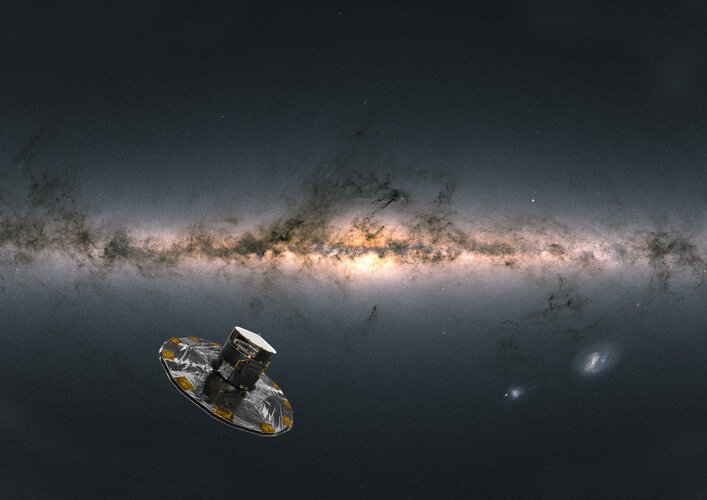Biomass satellite to lift off aboard Vega C in late April
Thursday, 27 March 2025 21:21 On Tuesday, April 29, 2025, at 6:15 a.m. local time (09:15 a.m. UTC, 11:15 a.m. CEST), Arianespace will launch ESA's Biomass Earth Explorer satellite aboard a Vega C rocket from Europe's Spaceport in French Guiana. Designated flight VV26, the mission aims to deliver the satellite into a Sun-Synchronous Orbit approximately 666 kilometers above Earth. The satellite will separate from the launcher
On Tuesday, April 29, 2025, at 6:15 a.m. local time (09:15 a.m. UTC, 11:15 a.m. CEST), Arianespace will launch ESA's Biomass Earth Explorer satellite aboard a Vega C rocket from Europe's Spaceport in French Guiana. Designated flight VV26, the mission aims to deliver the satellite into a Sun-Synchronous Orbit approximately 666 kilometers above Earth. The satellite will separate from the launcher Senator raises concerns over Air Force possibly shifting satellite contracts to SpaceX
Thursday, 27 March 2025 21:01
The potential realignment comes as the Pentagon scrutinizes its funding plans for fiscal year 2026.
The post Senator raises concerns over Air Force possibly shifting satellite contracts to SpaceX appeared first on SpaceNews.
Miles Space flight tests water-fueled thruster
Thursday, 27 March 2025 20:19
SAN FRANCISCO – Miles Space has demonstrated a water-fueled electric thruster with unusually lower power demands.
NEO surveyor instrument enclosure tested inside historic chamber for Apollo spacecraft testing
Thursday, 27 March 2025 19:49This request seems a bit unusual, so we need to confirm that you're human. Please press and hold the button until it turns completely green. Thank you for your cooperation!
Press and hold the button
If you believe this is an error, please contact our support team.
185.132.36.159 : 4a49f568-0f3b-4abb-b514-6a59448f
Booz Allen unveils ‘Brilliant Swarms’ satellite concept for missile defense
Thursday, 27 March 2025 18:26
Brilliant Swarms would consist of up to 2,000 small satellites operating as an interconnected network
The post Booz Allen unveils ‘Brilliant Swarms’ satellite concept for missile defense appeared first on SpaceNews.
China unveils planetary exploration roadmap targeting habitability and extraterrestrial life
Thursday, 27 March 2025 17:58
ESA taps Thales Alenia Space to build digital twin for European agriculture
Thursday, 27 March 2025 17:28
Europe has contracted Thales Alenia Space to develop a digital twin of agricultural systems, combining satellite data and crop modeling to support sustainable and climate-resilient farming practices across the continent.
Proba-3's first autonomous formation flight
Thursday, 27 March 2025 13:41
Two spacecraft flying as one – that is the goal of European Space Agency’s Proba-3 mission. Earlier this week, the eclipse-maker moved a step closer to achieving that goal, as both spacecraft aligned with the Sun, maintaining their relative position for several hours without any control from the ground.
Not Just for Engineers: Broadening the Space Pipeline
Thursday, 27 March 2025 12:34
In this week's episode of Space Minds, Sara Alvarado, Executive Director for the Students for the Exploration and Development of Space, known as SEDS, sits down with host David Ariosto.
Cygnus mission to ISS scrapped after finding spacecraft damage
Thursday, 27 March 2025 10:51
NASA and Northrop Grumman will not launch a Cygnus cargo mission to the ISS in June as previously planned after discovering the spacecraft is damaged.
Earth 1, asteroids 0: The next generation of planetary defense takes shape at NASA's Jet Propulsion Laboratory
Thursday, 27 March 2025 10:49This request seems a bit unusual, so we need to confirm that you're human. Please press and hold the button until it turns completely green. Thank you for your cooperation!
Press and hold the button
If you believe this is an error, please contact our support team.
185.132.36.159 : 69dc0faa-6fab-4b30-80ff-856b90d4
Anywaves poised to expand antenna production in France and internationally
Thursday, 27 March 2025 10:00
SAN FRANCISCO – French antenna manufacturer Anywaves announced plans March 27 to begin producing satellite antennas and radio-frequency payloads in-house, a prelude to establishing a U.S.
Farewell, Gaia! Spacecraft operations come to an end
Thursday, 27 March 2025 09:00
The European Space Agency (ESA) has powered down its Gaia spacecraft after more than a decade spent gathering data that are now being used to unravel the secrets of our home galaxy.
On 27 March 2025, Gaia’s control team at ESA’s European Space Operations Centre carefully switched off the spacecraft’s subsystems and sent it into a ‘retirement orbit’ around the Sun.
Though the spacecraft’s operations are now over, the scientific exploitation of Gaia’s data has just begun.
ESA’s Gaia spacecraft leaves for retirement orbit
Thursday, 27 March 2025 09:00 Video:
00:02:00
Video:
00:02:00
From 25 July 2014 to 15 January 2025, the Gaia space observatory performed high-precision measurements of nearly two billion stars from its Lissajous orbit around the L2 Lagrange point, 1.5 million km from Earth.
After 10.5 years of groundbreaking observations, Gaia’s cold gas supply for attitude control has been depleted. On 27 March 2025, Gaia will leave its Lissajous orbit and transition into a stable heliocentric orbit. Soon after, the spacecraft will be passivated, with its instruments and transmitters switched off.
While Gaia will no longer collect new data, its scientific mission is far from over! The team continues


